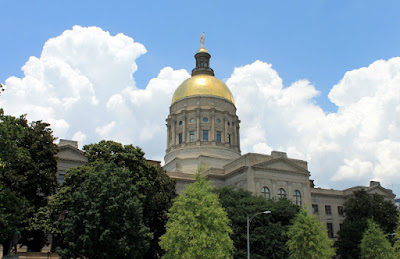We moved on to Atlanta where I wanted to check out a couple of places from when I was stationed there almost 50 years ago. We also wanted to tour the M.L. King historic site and the Carter Presidential Library and Museum. Of course, also on our to do list were a couple of local brew pubs and we were not disappointed. Near where we stayed in Stone Mountain we found Summits Wayside Tavern where they have 116 beers on tap and a very nice menu. It turns out the bartender, Dan, was from the WashPA area and knew a couple of people we know. Small world. In Atlanta we went to two brewpubs, Wrecking Bar and Max Lager's, where the beer was great at both. Bad side at Max Lager's, which is advertised as having wood-fired pizza, was that they had a fire the week before so they had no pizza. Very disappointing.
Atlanta is the fifth capital city of Georgia and the present capitol building was built in the late 1880's. It is the classic design with two wings for the House and Senate on the third floor and two wings for offices. The office of the Governor, Lieutenant Governor and Secretary of State are on the second floor under the legislative chambers.
Georgia has 56 senators who meet in the east wing.
There is a skylight above the north and south wings which have open grand staircases from the second to the fourth floor which was made a "temporary" museum in 1895. The museum, with exhibits of Georgia's natural resources and history, is still there today.
The House of Representatives with 180 members meets in the west wing.
The dome is painted with 43 ounces of native Georgia gold. It has been repainted three times since 1889. There are several statues and sculptures on the capitol grounds. This is Richard Russell who served in the Georgia house, as governor and as U.S. senator.
On top of the dome is the statue of a female figure of Freedom with the raised torch and lowered sword to commemorate the war dead.
There are portraits of all Georgia governors and many prominent natives in the capitol. These three show how Georgia has changed since I lived there years ago. Left is Lester Maddox who was governor when I lived there. He was a segregationist who closed his restaurant rather than serve Blacks. Ironically, most of his employees were Black. Center is Jimmy Carter who followed Maddox as governor and stated in his inauguration speech that "the time for racial discrimination was over". Right is Martin Luther King who was killed when I lived in Atlanta. Maddox would not allow his body to lie in state in the capitol and stationed 160 state troopers around the perimeter during the funeral to keep people out. While there were riots in many cities after King's assassination, Atlanta was calm even with over 250,000 people attending the funeral.
This statue honors the 32 Republican African Americans who were elected to the Georgia legislature in 1868 during Reconstruction after the Civil War. In August of that year the white majority voted to expel them thus denying a voice to those who had voted for them.
Statute of Jimmy Carter; Georgia legislator, governor, President of the United States and Nobel Peace Prize winner. Georgia has come a long way.
We have discovered that every state was given a replica of the Liberty Bell in 1950. The bell here is displayed in Liberty Plaza with the names of the three Georgians who signed the Declaration of Independence.
I was disappointed to find that Fort McPherson, where I was stationed from 1966 to 1968, was now closed and I could not get on the old base. I could see the hospital where I worked, but that was about it. So much for a walk down memory lane.
While I was in the Army and for a few months after I got out I worked at Grady Hospital. Another look back at how Georgia has changed. When Grady was built during segregation there was two of everything side by side; restrooms, newborn nurseries, operating rooms and emergency rooms, one marked Whites Only and the other Colored.
As I write this the news is filled with stories about the confederate battle flag and by extension the glorifying of the confederate culture. That culture existed on a system of slavery and exploitation to maintain the lifestyle of the southern gentry. The sculpture on Stone Mountain is another example of that glorification. While the idea for a memorial goes back to the early 1900's with two different sculptors working on it over the years, the final memorial that you see today was started in 1964 and completed in 1968. Of course, it was during the Civil Rights movement that the state of Georgia decided to carve a memorial to Davis, Lee and Jackson, three men who turned against the UNITED States of America. Maybe some day they will carve Georgia's two Nobel Peace Prize winners, Martin Luther King and Jimmy Carter, into the mountain. (next post)
















1 comment:
Its interesting that treason is espoused by some many today. They should all go to Gettysburg and view the Peace monument.
Post a Comment